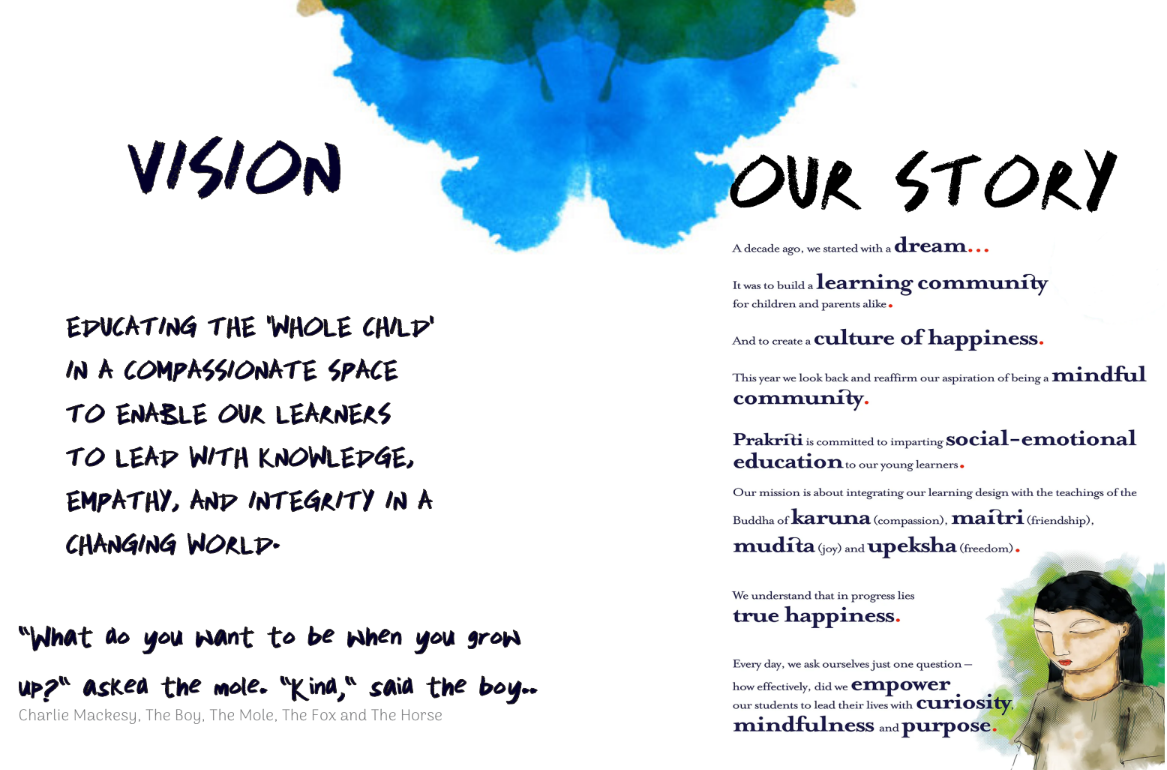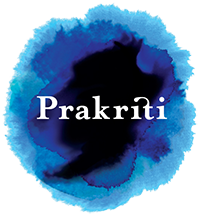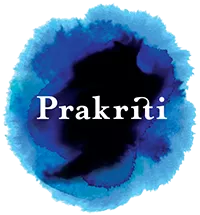Admissions
See the Picture Gallery of the new Campus here
Have questions? Please read our frequently asked questions

To register your child for admission to Prakriti, please fill the form using the “Register for admission” button on this page.

Frequently Asked Questions
(with inputs from our parents)
Prakriti Way of Learning
Sri Aurobindo had said, “nothing can be taught, it can only be learnt” and “learning goes from near to far”. Our education model revolves around facilitation and NOT teaching. Facilitation is a collaborative process where the teacher works together with the learners on developing experiences and curating resources so that the child is able to stretch beyond what he/she already knows to the zone of deep learning. Our facilitators are continuously researching and learning new ideas, teaching technologies as well as pedagogies. Examples of projects in Grade 4 can be found here. Some other key aspects of the learning programme at Prakriti are Connect with Nature and Socio-Emotional Learning.
How do you impart Socio-Emotional Learning?
From early years, we work on listening to ourselves, our inner being, as a habit. The learners have a circle time with the facilitators to talk freely about themselves, their peers as well as their immediate environment. Processes like developing rules for the classroom democratically, naming their group at the beginning of the year themselves are some of the ways through which we cultivate self-management and inner discipline. Prakriti children engage a lot in reflective writing and drawing to express their feelings. Older children meet with their facilitators in one-one sessions to express themselves openly and receive what their “didis” have to say. The school also provides proactive counselling to adolescents and parents.
Is spirituality important to the School?
Prakriti believes that India has a very rich heritage in Vedas, Buddha, Yoga and Vedanta that needs to be appreciated by the learners. We inculcate the sense of pride and imbibing the values through classroom discussions, readings, interactions with senior Hindu and Buddhist monks, celebrating secular festivals and chanting the Sanskrit hymns for the Divine power in all of us.
Does the experiential learning methodology work in middle and senior grades?
Absolutely. Experiential learning happens in a variety of forms. If it is by visualising, contextualising, touching, feeling and observing in early years, it is through enacting, reading stories in-context, going to factories and museums for enquiry and researching the topics for deep-learning. We have maker- and tinkering-labs for science experiments and creative modelling. Languages are taught in an inter-disciplinary way combining visual arts, theatre and literature. The approach works very well for deep learning in middle school. Cambridge (IGCSE) subjects lend themselves to enquiry and group projects in high school.
What is the language of instruction and communication in school, especially in the early years? Does learning English late hamper their ability to interact in English?
Prakriti is a bilingual school with English and Hindi as language of instruction in the early years. We start teaching Hindi formally in ages 3 and 4 and move to English reading and writing by age 4.5. Children who have a good command of the mother tongue are found to pick up multiple languages easily. In our experience, Prakriti learners are proficient in both English and Hindi, reading, writing and speaking, by the time they are 7, i.e, in Grade II.
How many students are there per facilitator?
There are around 12-15 learners per facilitator, which is a very healthy ratio. In early years (K-2), the learner-facilitator ratio is 7:1. We strongly believe in addressing the learning needs of each learner based on their interests, cultural background and prior knowledge. With a small class size, we are able to work on creating learning programmes that work for each child.
How do you ensure one-on-one attention is being given to each student?
We work with learners individually, in small groups. We develop learning goals (which includes, physical, emotional, core subjects and arts) for each child and work through the year in collaboration with the parents to track progress and reinforce learning at school and home. We have a practice of “bubble time” where a child can speak to the facilitator freely and vice-versa. We meet with each parent/family individually at least twice in a year over detailed meetings with all subject facilitators to discuss the observations about each learner.
Low student ratio per class does give individual attention but does it promote healthy competition?
Competition is usually within your own self; this requires the art and skill of deep self-reflection, a life skill that we develop in learners at Prakriti.. Competition with self and cooperation with others is the essence for bringing out the best in a child. We prepare our kids to face the real world.
How do children learn arts and music in Prakriti?
We have an all-year programme on Arts with quarterly modules on Theatre, Visual Arts, Music (vocals and instrumental) and Dance. All learners go through all the modules until they begin to specialise by Grade 8. Our Arts facilitators are highly qualified and specialised.
For presentations, both in-school and external, a lot of times the children take the lead in planning and executing the program – they ideate, write, compose, edit – with the facilitators giving them ample support and direction, as required.
What facilities do you have for sports?
We have dedicated sports time every day for all classes. We emphasize on physical stamina and strength building through gymnastics, cycling and swimming for all ages. We have facilities for basketball, badminton, skateboarding, volleyball, table tennis, squash and football on campus.
How do you assess academic skills?
We begin formal graded examinations in Grade 9. Before that in Grades 6-8 we assess learners in a system of formative (feedback to the teacher) and summative (feedback to the learners) tests. Both of these tests are informal and are conducted within the regular school.
We also assess children on aptitude in various subjects using a standardised test called ASSET, administered over 4,00,000 children across private and public schools in India. Would it be relevant to mention the ATS also here – its at a national level, and gives exposure to the children of an external examination set-up?
We observe children round the year on socio-emotional skills, physical ability, learning styles and habits.
Our annual report is quite rigorous and comprehensive where we include a child’s learning on holistics learning:
- emotional well-being
- social learning
- physical stamina and strength
- cognitive ability
- subject-specific learning, expression and learning styles
We set the learning goals with the participation of the parents and maintain a living document that can be referenced for measuring progress. The year-end reports also present a plan for parents and teachers to work together to address the gaps and hone the strengths.
How do Prakriti children fare in comparison with children from other schools?
Learner-centered systems of education do not focus on competing with the peers or standardised metrics. Yet, as we follow the goals laid down by National Curriculum Framework in India (NCERT) and Cambridge International, our children are at the similar learning levels as their peers in other schools. They get there joyfully.
School’s Mission
Deep learning cannot be facilitated in crowded classrooms. Having said that every school needs to sustain itself. We keep our overheads low and focus on having classrooms with very highly skilled facilitators. We have grown in the last nine years, organically, to be a K-12 school now. We are not focused on excess profits/surplus.
How do you pitch yourself against more aggressive institutional power?
We have not felt the need to pitch ourselves against institutional establishments. Our community, of parents and learners, is our biggest ambassador and it is the reason we have grown organically over the past three years. We are a self-funded organisation and thus not answerable to outside investors. We believe that our education programme differentiates us from other schools, in the minds of the new parents, and as such we don’t need to advertise.
You have a fee structure comparable to established schools with various facilities. How do you justify it?
We do not have any hidden charges for uniform, stationery, computers, projects etc. We are an Cambridge International school and have to uphold academic standards with rigour.
We feel that our fee structure is well-justified by the low student to facilitator ratio and compassionate facilitators who are working with an individualised facilitation approach not didactic teaching.
Prakriti is a green campus and ensures a healthy and natural environment, several field and farm trips in a year. We work not only with the children but also the parents with several group meetings with whole classroom parents, discussing the goals and learning approaches. All these features are part of Prakriti fee.
Why don’t you believe in school uniforms? Does it not lead to differentiation in classrooms?
Uniforms are required in industrial set-ups. Learners extend home learning to school when the enabling environment is kept the same.
A school uniform also adds an extra and unnecessary financial burden on a family.
We ensure that children wear normal and comfortable clothes and it doesn’t lead to differentiation. We discuss with the families wherever there is a deviation from this norm.
Do you encourage competition?
We encourage learners to compete with themselves. Each child participates in sports day and gets a medal, there are no differentiated medals. Formal grades are not awarded until Grade 9. We do not publish results of assessments to a group (or class). Individual reports are kept confidential and discussed only with the parents.
What are the prospects after Prakriti, if a child is leaving before Grade 10? Do you find any gaps in Prakriti children’s learning?
Our curriculum is aligned with the Cambridge curriculum as well as with the National Curriculum Framework set by NCERT so that the learners are achieving the baseline learning outcomes expected of them, when they move schools. In the past, the children who have moved out of Prakriti, have adjusted well in the mainstream schools. Measures of learning outcomes testing such as ASSET have reported above-average learning levels for most of our learners. See what parents say about this here:
Affiliation
We are affiliated to Cambridge Assessment International Education (CAIE). It is also known as International General Certificate for Secondary Education (IGCSE). We follow the learning outcomes defined by Cambridge while also meeting the goals set by National Curriculum Framework (NCF) in India.
What is IGCSE or Cambridge affiliation?
Over 10,000 schools in over 160 countries around the world offer Cambridge qualifications. CAIE is a division of Cambridge Assessment, a not-for-profit organisation and part of the world renowned University of Cambridge. Cambridge IGCSE is the world’s most popular international qualification for 14 to 16 year olds. It is taken in over 150 countries and in more than 4800 schools around the world. In India, here are about 400 schools that are affiliated with Cambridge.
Why has Prakriti chosen Cambridge affiliation?
We have chosen Cambridge over other boards because it offers freedom to learn in the way learners and teachers define together as the best way to learn rather than teaching to test. The learning outcomes defined by Cambridge are very well aligned with 21st Century skills for the learners- Critical Thinking, Communication, Collaboration and Creativity.
Which degree/certificate will the children have in Class 12?
We will offer International Baccalaureate Diploma Programme (IBDP), offered by IB, Geneva. IBDP is the most popular high school degree programme.
Is Cambridge/IBDP acceptable by Indian Universities?
Yes. Most public and private universities accept Cambrirdge and IBDP certificates. In fact, Association of Indian Universities, https://www.aiu.ac.in/, set up by the UGC Act provides an equivalent certificate for use by national universities, if the child has an international degree or diploma such as IGCSE A Levels or IBDP.
What are the prospects after Grade 12 for an International Certificate?
A child from Prakriti would integrate into any other school as easily as they would from any other school. There have been some children who have needed to move out from Grades 1-5 and have adjusted well at other mainstream schools. Grade 10 and 12 students will have internationally and nationally recognized degree certificates to be accepted in any system.
Teachers
We hire multi-discipline qualified teachers with learner-empathy, research-orientation and respectful communication as the most important skill sets over experience or academic background. All teachers, cleaning and security staff are called didi-bhaiya to develop familial affinity with the children and to signal lack of special status to any profession.
In middle school, our facilitator pool has significant non-teaching experience to offer diversity and real-world experience. Our current classrooms have a biochemist teaching Natural Sciences, a Hindi Theatre artist and language expert teaching Hindi and an English litterateur and Pali language scholar teaching English.
In primary and early years programmes, our teachers have progressive education gathered within Prakriti or schools like Mirambika/Azim Premji University. Freshers from B.El.Ed. programme of Delhi University join us every year and undergo a year of on the job training.
How do you motivate and retain your teachers?
We build a culture of respectful communication, personal and professional growth for our facilitators. In a joyful, small-classroom learning environment with experiential curriculum, facilitators teach and learn as well. We mentor our facilitators continuously in a structure of professional mentors/researchers assisting the teachers with planning, delivering and assessing the learning outcomes. Founders of the school are directly involved with mentoring the teachers themselves.
Learners with Special Needs
We have a well-established “Bridge” programme with a team of 45 special educators who work with learners with various physical and learning disabilities and special needs. Our counsellors are trained in identifying these needs and working with parents and facilitators to develop modifications and accommodations in curriculum and assessments. We create Individual Education Plans (IEPs) in the beginning of the year in collaboration with the special educators and the parents. We have special educators who work with specific needs such as ADHD, ASD, Dyslexia/Dyscalculia and emotional needs such as anxiety disorders.
Does integration of special needs children in classes not create a bias in the minds of “normal” children? Does it not get disruptive?
No. We integrate a small number in every class. Typically, the mild learning disabilities are supported by the teachers in the classroom through modifications and accommodations for such learners. Severe disabilities are handled by shadow facilitators who are always present with the children in the classroom.
We reinforce our culture of appreciating differences and valuing classroom equity throughout the year. We find that the students’ own learning and their world-view changes in a diverse classroom.
